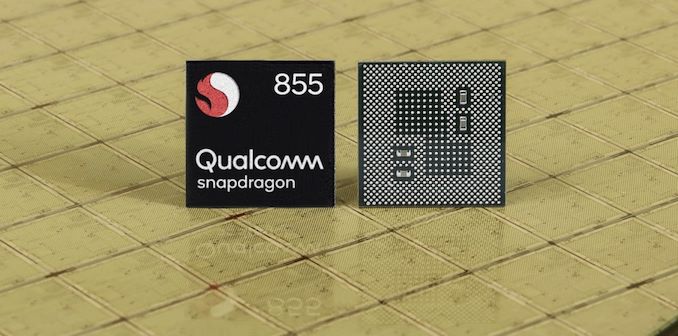The Snapdragon 855 Performance Preview: Setting the Stage for Flagship Android 2019
by Andrei Frumusanu on January 15, 2019 8:00 AM EST- Posted in
- Mobile
- Qualcomm
- Smartphones
- SoCs
- 7nm
- Snapdragon 855
Final Thoughts
2018 has been a very successful year for Qualcomm and the Snapdragon 845. The company had provided an extremely solid and well-rounded SoC for device vendors to build their flagship devices on- and by the looks of it the Snapdragon 855 continues this trend.
I’ve been a bit sceptical about the merits of Qualcomm’s 1+3 CPU configuration, however after seeing the preliminary performance and power efficiency figures of the new prime core on the new chipset, I’m not nearly as concerned. We reserve any final verdict for when we will have tested final commercial devices, as that’s where in the end we’ll also see the efficiency effect of the non-prime cores, and how they’ll position themselves against the competition.
Performance wise, the Snapdragon 855 is a bit odd. In steady-state workloads like SPEC the chipset is seemingly performing very well and matches or exceeds the new Kirin 980. Here Qualcomm’s changes to the CPU microarchitecture might even actually be visible in the test results, which is a nice feat. Unfortunately the memory subsystem still seems to include some of DRAM latency regressions that we also saw in the Snapdragon 845, both which are due to Qualcomm’s system level cache.
Real-world performance, while still excellent, doesn’t quite manage to reach my expectations I had for the chipset. Here for whatever reason, the chip’s improvements are not nearly as pronounced as in the more synthetic tests. Again the odd thing is that the Kirin 980 still manages to beat the Snapdragon 855 in near most of these workloads. Qualcomm had reasoned that the microarchitectural changes to the CPU were meant to help web browser performance, yet it’s here where the chip slightly lags behind the competition – I do wonder if this is a case of the CPU again being limited by either Qualcomm’s choice of more conservative caches or due to the latency penalty of the system cache.
Although the performance shown today is exemplary, it still does look maybe a little rough around the edges in some of our system performance tests – here maybe Qualcomm will be able to investigate and further improve things until we actually see commercial devices.
Whether the system performance will be improved in final devices or not, what is clear though is that power efficiency looks outstanding. Qualcomm had me worried as the PR teams had avoided talking about efficiency during the chipset’s launch, but the results today (even if they’ll need to be verified), look very promising and should result in notable battery life improvements in 2019’s devices.
On the GPU side of things, Qualcomm’s more muted performance projections of 20% were because the company has again focused a good part of the process improvements into bringing the overall power back down from the usually higher levels that we saw on the Snapdragon 845.
Overall – the Snapdragon 855 looks to be another extremely well executed SoC from Qualcomm, and I’m looking forward to validating the results and testing out the first commercial devices once they become available.











132 Comments
View All Comments
tipoo - Wednesday, January 16, 2019 - link
That would be physics.id4andrei - Wednesday, January 16, 2019 - link
Indeed. When you provide a small battery to a powerful SoC you get degraded batteries before the two year warranty(Europe). Problem is Apple's own store diagnostics validated batteries from throttled iphones.melgross - Wednesday, January 16, 2019 - link
Better batteries than Android phones.id4andrei - Wednesday, January 16, 2019 - link
Millions of iphone users walked and some keep walking around with throttled iphones. Let that sink in.Trackster11230 - Thursday, January 17, 2019 - link
Based on the context of this thread, having a throttled SOC that's still well ahead of the competition would still provide a great experience. You dug yourself into a hole with that comment.Sailor23M - Thursday, January 24, 2019 - link
“The” iphone :-)Solandri - Friday, February 15, 2019 - link
What's interesting to me is that its performance per Watt seems to be pretty close to the A12. Which more or less confirms what I've suspected for a while - that a large part of the superior performance of the A12 is simply due to Apple getting priority at the newer 7nm fabs. While the A12 vs 845 comparison made chronological sense (in that both were available in phones at the same time), the A12 was 7nm while the 845 was 10nm.jonrevis1985 - Sunday, February 17, 2019 - link
So true Oyeve, you could put a turbo charged v8 in a ford pinto but it will only ever be a pinto.goatfajitas - Tuesday, January 15, 2019 - link
Catch Apple, no. Alot of the performance is tight integration, not actual CPU speed. If Apple had used Qualcom Snapdragon and Android OEM's had the A12, Apple would still be faster at benchmarks. Take it all with a grain or 10 of salt.Ironchef3500 - Tuesday, January 15, 2019 - link
Very true